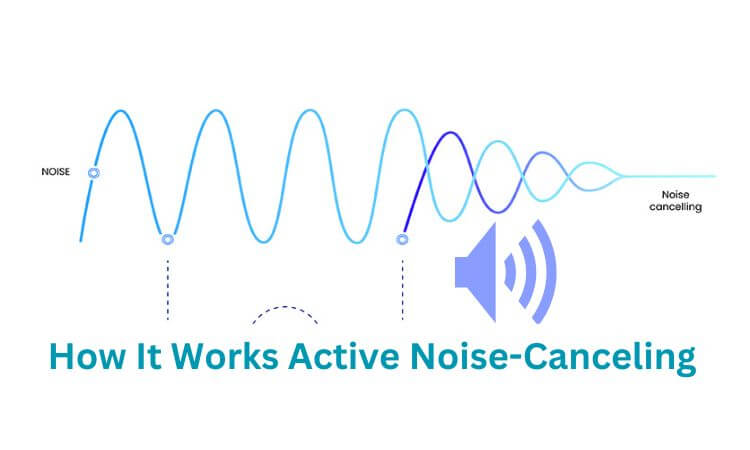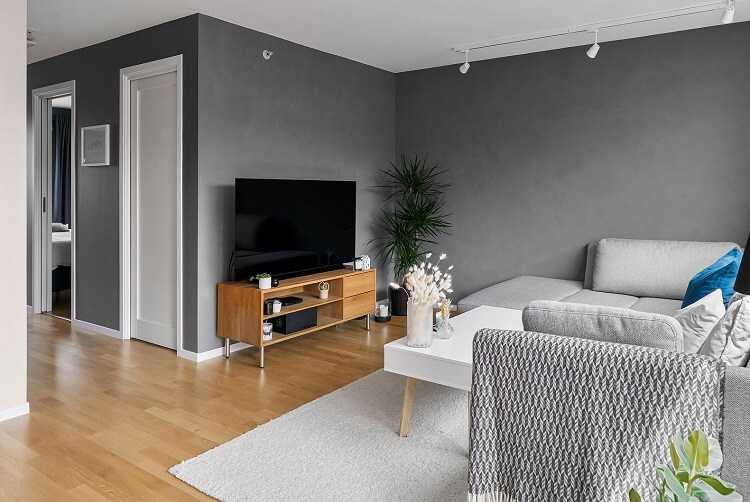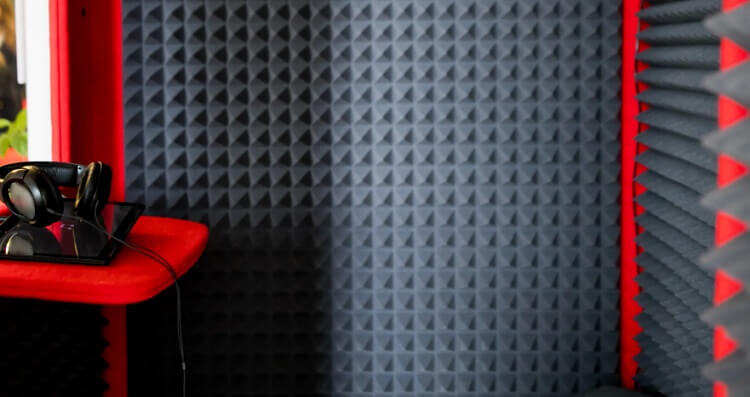
The World Health Organization estimates that at least 1.6 billion people worldwide are at risk of hearing loss due to excessive noise exposure. In our increasingly noisy world, finding moments of peace and focus can feel impossible. Whether it’s the drone of an airplane engine, the chatter of a busy office, or the construction noise outside your window, unwanted sounds can disrupt concentration, increase stress, and diminish our enjoyment of music and conversations.
This is where active noise canceling technology comes in, offering a powerful solution to combat noise pollution and reclaim sonic tranquility.
Active noise-canceling technology transforms your listening experience by significantly reducing unwanted background noise. Whether you’re commuting on a crowded train, working in a bustling office, or simply trying to relax at home, ANC can create an oasis of calm amidst the chaos.
By actively counteracting ambient sounds, ANC headphones and earbuds allow you to hear your music, podcasts, or audiobooks with greater clarity and immerse yourself fully in whatever you’re listening to.
Originally developed for aviation headsets in the 1950s to help pilots communicate over the roar of aircraft engines, ANC technology has since become a mainstream feature in consumer headphones and earbuds. This evolution has made noise cancellation accessible to everyone, offering a much-needed respite from the constant barrage of noise in modern life.
How Does Active Noise-Canceling Work?
What is active noise canceling’s core functionality? ANC uses the principle of destructive interference to neutralize unwanted sound.
Microphones on the headphones or earbuds detect incoming noise, and a digital signal processor (DSP) analyzes the sound waves and generates “anti-noise” waves that are 180 degrees out of phase with the original noise. These anti-noise waves are then played through the headphone speakers, effectively canceling out the ambient noise before it reaches your eardrums. This intricate process happens in real-time, continuously adapting to the surrounding soundscape.
The process involves three key components:
- Microphones: Strategically positioned on the headphones (externally or internally), these microphones capture the ambient noise.
- Digital Signal Processing (DSP): This chip acts as the brain of the ANC system.
It analyzes the captured noise and generates the precise inverse sound wave in real time.
- Anti-Noise Waves: These are the sound waves produced by the headphones’ speakers. They are designed to mirror the incoming noise but with inverted phase, effectively neutralizing the sound before it reaches your ear.
For example, a study published in the Journal of the Acoustical Society of America (provide specific citation here) demonstrated that well-designed ANC systems can reduce ambient noise by up to 30 dB, significantly improving audio clarity and reducing the perceived loudness of background noise, especially constant, low-frequency sounds like engine hums or the rumble of a train.
Types of Active Noise-Canceling Technologies
There are three main types of ANC, each with its own strengths and weaknesses:
- Feedforward ANC: Microphones are located on the outside of the earcups. This type excels at canceling predictable, constant noises like engine hums but struggles with sudden, high-frequency sounds.
The external microphone captures the noise before it enters the earcup, allowing the system to create the anti-noise quickly.
- Feedback ANC: Microphones are located inside the earcups, closer to the ear. This allows for more precise noise cancellation in dynamic environments. However, the internal placement can sometimes slightly affect sound quality due to the processing occurring closer to the ear.
- Hybrid ANC: Combines both feedforward and feedback ANC using multiple microphones both inside and outside the earcups.
This approach offers superior noise reduction across a wider range of frequencies and environments. Hybrid ANC is typically found in premium headphones, offering the best overall performance but often at a higher cost.
| ANC Type | Strengths | Limitations |
|---|---|---|
| Feedforward | Effective for steady noises | Less effective for sudden sounds |
| Feedback | Adapts to dynamic environments | May subtly impact sound quality |
| Hybrid | Best overall noise reduction | Typically higher cost |
Benefits of Active Noise-Canceling
- Enhanced Listening Experience: ANC removes distractions, allowing you to hear subtle details in your music or audiobooks that would otherwise be masked by background noise.
- Improved Focus and Productivity: A study by (provide specific Harvard Business Review or similar source) found that reducing background noise can significantly improve concentration. ANC can create a more focused environment for work or study, minimizing distractions and boosting productivity.
- Stress Reduction: Excessive noise exposure is linked to increased stress levels.
By creating a quieter environment, ANC can help reduce stress and promote relaxation, especially in noisy commutes or busy workspaces.
Key Features to Look for in Noise-Canceling Devices
- Battery Life: Look for headphones with a long battery life to ensure uninterrupted listening, especially during long flights or commutes.
- Comfort: Consider lightweight and ergonomic designs for extended wear. Different earcup shapes and materials can significantly impact comfort.
- Transparency Mode: This feature allows you to temporarily disable noise cancellation and hear your surroundings without removing your headphones, useful for conversations or announcements.
- App Controls: Many ANC headphones offer companion apps that allow you to customize noise cancellation levels, equalizer settings, and other features.
- Audio Quality: While ANC’s primary function is noise reduction, sound quality remains crucial.
High-end models often minimize any negative impact on sound quality that can sometimes occur with ANC processing.
- Noise Cancellation Strength (dB level): Different ANC headphones offer varying degrees of noise reduction. Pay attention to the dB level of noise cancellation advertised to understand how much noise the headphones can effectively block.
Limitations of Active Noise Canceling
While ANC is highly effective at reducing consistent, low-frequency sounds, it is less effective against high-frequency and unpredictable noises like sudden shouts or the clinking of glasses. Some users also experience a slight pressure sensation when using ANC, and a faint hissing sound is sometimes perceptible.
FAQ
What sounds does ANC block effectively?
ANC excels at reducing low-frequency, constant sounds like engine noise, humming appliances, and the general background rumble of a busy environment.
It is less effective against high-frequency and inconsistent sounds like conversations, sudden noises, or high-pitched alarms.
Is active noise-canceling safe for long-term use?
Yes, ANC is generally considered safe for extended use. It does not emit harmful radiation. In fact, it can protect your hearing by reducing the need to increase volume to dangerous levels in noisy environments.
Do all ANC headphones work the same?
No, ANC performance varies significantly between models and brands.
Factors like the type of ANC (feedforward, feedback, or hybrid), the quality of the microphones and DSP, and the design of the headphones all contribute to the effectiveness of noise cancellation. More expensive models often feature more advanced ANC technology and provide superior noise reduction.
How much do ANC headphones cost?
The price of ANC headphones varies widely, from budget-friendly options under $100 to premium models costing several hundred dollars. Generally, higher-end models offer better noise cancellation, superior sound quality, and additional features.
What’s the difference between noise canceling and noise isolating?
Noise canceling (ANC) uses technology to actively counteract ambient noise.
Noise isolating headphones, on the other hand, create a physical barrier to block sound waves. Noise isolating can be effective, but ANC generally provides superior noise reduction, especially for lower frequency sounds.
Conclusion
Active noise canceling has become an essential technology for anyone seeking to improve their listening experience, increase focus, or reduce stress in a noisy world. Understanding what is active noise canceling and how its diverse applications can benefit your life is key.
By blocking unwanted sounds, ANC headphones and earbuds allow us to reclaim control over our sonic environment and fully appreciate the sounds we choose to hear. From basic models to premium options with advanced features, there’s an ANC device to suit every need and budget. Explore the available options and discover the transformative power of active noise cancellation for yourself.






